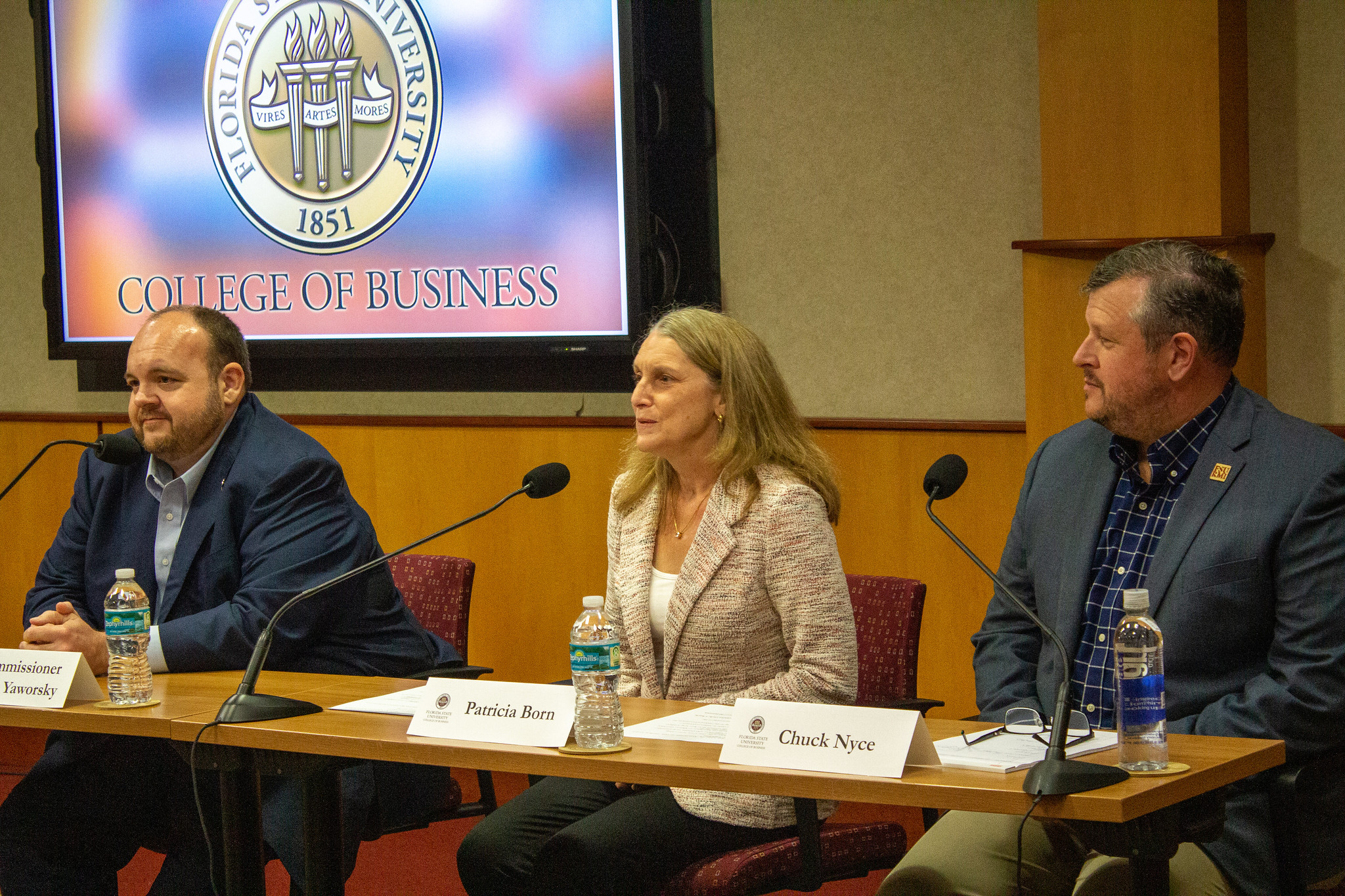RMI faculty members help effort to defuse Florida’s property insurance ‘timebomb’
Litigation, mitigation, affordability, uncertainty and, of course, tropical activity emerged as key topics Thursday during a panel discussion in the Florida State University College of Business on Florida’s property-insurance crisis.
“Uncertainty – we have a lot of that in our marketplace for a number of reasons,” Florida Insurance Commissioner Michael Yaworsky said. “And that’s one of the worst things you can have in insurance.”
Yaworsky participated in the discussion – “Diffusing the Timebomb: Can Property Insurance in Florida Be Made Affordable or Will We Price Future Floridians Out of the State?” – with College of Business faculty members Charles Nyce and Patricia Born, both globally acclaimed scholars in risk management and insurance.
Gabriel Carrillo, executive director of FSU’s Center for Risk Management Education and Research, moderated. The College of Business hosted the event in partnership with the LeRoy Collins Institute, in FSU's College of Social Sciences and Public Policy.
The discussion came as more insurance companies withdraw from Florida’s property-insurance market amid losses from increased hurricane activity and the promise of more catastrophic storms. That has left state residents with limited alternatives and alarmingly higher costs; Florida residents reportedly now pay more than triple the national average for property insurance.
Much of Thursday’s discussion focused on solutions.
Born, FSU’s Payne H. & Charlotte Hodges Midyette Eminent Scholar in Risk Management & Insurance, emphasized the need for innovation and agility from insurance companies.
“Climate change is coming faster and faster,” she said. “We need insurance companies to be able to adapt to that, and I think that includes being able to change rates and get quick turnarounds on rates.”
Nyce, the Dr. William T. Hold Associate Professor of Risk Management and Insurance and chair of the Department of Risk Management/Insurance, Real Estate and Legal Studies, pointed out that big storms aren’t going away.
“So, the question is, ‘How do you get long-term partners and incentivize them to be here and have a functioning marketplace?’” he said. “The answer is balance: You have to get them a return on their investment.”
Nyce pointed to 1992 as the spark of Florida’s property-insurance “timebomb.” That’s when Hurricane Andrew hit South Florida as a Category 5 hurricane with wind speeds of 165 miles per hour. It claimed dozens of lives and destroyed tens of thousands of homes, with insured losses of $27 billion.
Nyce noted that Florida since has doubled the rate of U.S. population growth.
“It is very difficult to draw the path of a hurricane today without hitting a major area where there’s population,” he said. “The risk that was present 30 years ago is drastically different today: We have just more people in the way.”
He added: “No other state in the United States has our exposure or anywhere near the frequency of storms we do. And because of that, this is what we see going on in our property-insurance market.”
Yaworsky emphasized the number and severity of hurricanes in recent years. Those included Michael, which devastated parts of northwest Florida in 2018, and Ian, which destroyed parts of southwest Florida in 2022.
He said the uptick in hurricane activity after a decade of fewer storms led to increased reinsurance costs and an “unprecedented propensity for litigation within our marketplace.”
“The sheer number of insurance claims that were litigated became unsustainable, and those three things sort of actually rang each other’s bell, putting tremendous rate pressure on the entire industry,” Yaworsky said.
Insurance companies likely remain focused on two sources of uncertainty -- litigation and hurricane activity, Born said. Companies interested in operating in Florida will watch the effects of a 2022 Florida law that aims to, among many other things, discourage frivolous lawsuits and promote competition in the private-insurance market, she said.
Born said academia and government and industry leaders can play a role “in educating the Florida consumer who seems to think, ‘The only way I can get a claim paid is if I hire a lawyer’ – and they’re adding to the costs -- and to understand that there are avenues of getting claims paid without having to hire a lawyer.”
As for hurricanes, she said, advances in catastrophic modeling help to give insurers a “pretty good handle on what the storms look like,” decreasing uncertainty.
Yaworsky touted Florida as the only state that has developed its own model to predict broad effects of a catastrophe. The Florida Public Hurricane Loss Model estimates wind hazard, vulnerability and cost of insured losses.
“So data is a key to solving this problem over time,” Yaworsky said.
Other topics of discussion included:
- Debates over the appropriate role of the state-run Citizens Property Insurance Corp., the state’s so-called “insurer of last resort,” which has become Florida’s largest homeowner insurer but has begun moving some policyholders to private insurers.
- The Florida Hurricane Catastrophe Fund, a tax-exempt vehicle that reimburses residential property-insurance companies for a portion of their catastrophic hurricane losses in Florida. The fund now stands at $10 billion “and growing rapidly,” Yaworsky said.
- The question of federal funding and involvement.
- Increased calls for homeowners to mitigate storm damage through storm-resistant building materials and practices.
On a recent trip to southwestern Florida, Yaworsky noted a trend of new roofs featuring composite tile or other hurricane-resistant materials.
“There seems to be a good number of people who are putting in that investment to make sure they’re building back stronger,” he said. “I think ultimately we will reach a point where we will have this public-private relationship going on at all levels, and that includes at the consumer level,” where homeowners see “an advantage to make these changes so that the state then looks better to companies coming in.”
Watch the event for more details.
-- Pete Reinwald



